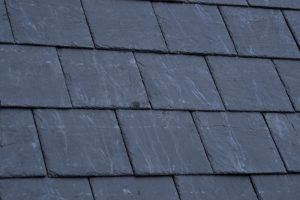Although slate roofing lasts decades, regular cleaning is essential so that your roof protects your property and looks attractive. Certain material can prevent slate from its natural ability to absorb water and delaminate during winter. Debris and moss, for example, hold moisture and can cause slate to split as water on the roof freezes.
Caring for your slate roof
 A sedimentary rock, slate features many tiny layers that naturally split. The rock’s properties make is a durable option for roofing and often lasts a lifetime. Once made into roofing material, soft slate easily absorbs water and naturally delaminates or splits during freezing and thawing. While more expensive, harder slates absorb less water and last longer.
A sedimentary rock, slate features many tiny layers that naturally split. The rock’s properties make is a durable option for roofing and often lasts a lifetime. Once made into roofing material, soft slate easily absorbs water and naturally delaminates or splits during freezing and thawing. While more expensive, harder slates absorb less water and last longer.
When cleaning a slate roof, it is important to take care. Slate roofing is usually installed with high quality components, including flashing and fasteners. Heavy-gauge copper is usually used for accessories and other materials. Copper corrodes when encountering certain cleaning chemicals, including chlorine bleach and ammonia. These chemicals could prematurely darken or tarnish copper. Along with strong chemicals, a pressure washer could damage your slate roof.
There are also several safety considerations. You are not able to walk on slate roofs like you can with other roofing. Since slate roof tiles do not sit flat against each other, it is easy to snap them when pressure is applied. Slate is also very slippery when wet. The best way to access a slate roof is with a long extension ladder. By placing the ladder flat against the roof, you will evenly distribute your weight on several of tiles.
How to approach cleaning
Cleaning should be limited to removing organic debris like moss and leaves. To remove moss as well as mould or rust, gently scrub with a medium-stuff brush and a mix of suitable roof slate cleaning products, such as household cleaner and water. If you see grey or grey-green streaks, these are usually from copper or zinc nails or flashing. They are harmless to slate and can help keep away moss, mould and other organic material.
You should also remove slate flakes from gutters, valleys and other areas around your roof and the chimney. It is best to use heavy rubber gloves to safely pick up the material. You should only remove debris from places you can reach from the ladder. A leaf rake can be used for areas that are difficult to reach.
To remove residual soap and remaining debris, gently spray your roof with a garden hose. Focus on one section at a time and adjust your ladder along the roof accordingly as you clean it. High pressure water including from pressure washers can break apart slate, particularly older or damaged tiles.
Yates Slate are a natural roofing specialist and distributor including Welsh slate and Cumbrian slate. Based in Lancashire, we offer decades of experience in supplying durable and attractive roof slates.

 01200 427711
01200 427711 info@yateslate.co.uk
info@yateslate.co.uk